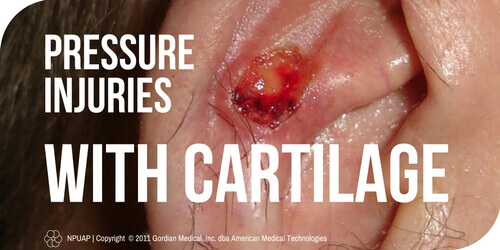When it comes to wound care, staging pressure injuries with visible or palpable cartilage doesn’t have to be complicated. Here’s what to do.
If you’ve ever treated wounds around the ear or in the area just below the bridge of the nose, you know how very little subcutaneous tissue there is. As a result, pressure injuries in these areas tend to be quite shallow, and they typically reveal cartilage.
So when encountering a pressure injury with visible or palpable cartilage, how should you stage it? We’ve got the answer.
What exactly is cartilage?
Cartilage is the flexible, rubbery connective tissue that cushions bones and joints. It is made up largely of water (65-80%), plus a matrix of proteins including collagens, proteoglycans and noncollagenous proteins. The composition of cartilage is quite distinct from bone, which contains only 10-20% water, and is made up primarily of collagen and inorganic bone mineral.
2007 NPUAP Definitions
The 2007 National Pressure Advisory Panel (NPUAP) staging definitions made no mention of cartilage – only bone, tendon and muscle. As a result, many clinicians were unsure of how to stage wounds with cartilage present. In 2012, NPUAP released the following statement:
Although the presence of visible or palpable cartilage at the base of a pressure ulcer was not included in the stage IV terminology; it is the opinion of the NPUAP that cartilage serves the same anatomical function as bone. Therefore, pressure ulcers that have exposed cartilage should be classified as a Stage IV.
New 2016 NPUAP Staging System
So what did the new 2016 NPUAP staging system tell us? They firmly reinforced their 2012 stand, including cartilage in the Stage 4 definition:
Full-thickness skin and tissue loss with exposed or directly palpable fascia, muscle, tendon, ligament, cartilage or bone in the ulcer. Slough and/or eschar may be visible. Epibole (rolled edges), undermining and/or tunneling often occur. Depth varies by anatomical location. If slough or eschar obscures the extent of tissue loss this is an Unstageable Pressure Injury.
And the answer is …
What does it all mean? It all comes down to this: if you can see or feel any cartilage in the wound, it is a Stage 4 pressure injury. It’s that simple.
Do you know the new staging system?
How well do you know your 2016 Staging Definitions? Click on the slideshow below to find out. (If you have any difficulty viewing, please click HERE).
What do you think?
In terms of staging pressure injuries with visible or palpable cartilage, have you encountered many wounds of this nature within your facility? Have you had difficulty staging them, and are there any particular challenges you’ve faced? We are interested in hearing about your experiences, so please leave your comments below.
Wound Care Education Institute® provides online and onsite courses in the fields of Skin, Wound, Diabetic and OstomyManagement. Health care professionals who meet the eligibility requirements may sit for the prestigious WCC®, DWC® and OMS national board certification examinations through the National Alliance of Wound Care and Ostomy® (NAWCO®). For more information see wcei.net.
What do you think?

